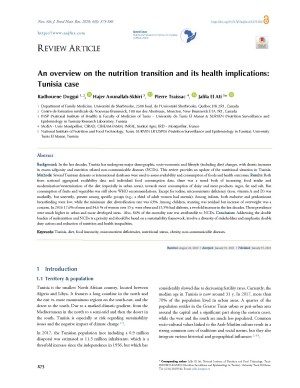An overview on the nutrition transition and its health implications: Tunisia case
Abstract
Background: In the last decades, Tunisia has undergone major demographic, socio-economic and lifestyle (including diet) changes, with drastic increases in excess adiposity and nutrition related non-communicable diseases (NCDs). This review provides an update of the nutritional situation in Tunisia. Methods: Several Tunisian datasets or international databases were used to assess availability and consumption of foods and health outcomes. Results: Both from national aggregated availability data and individual food consumption data, there was a trend both of increasing food intake and modernization / westernization of the diet (especially in urban areas), towards more consumption of dairy and meat products, sugar, fat and salt. But consumption of fruits and vegetables was still above WHO recommendations. Except for iodine, micronutrients deficiency (iron, vitamin A and D) was markedly, but unevenly, present among specific groups (e.g., a third of adult women had anaemia). Among infants, both exclusive and predominant breastfeeding were low, while the minimum diet diversification rate was 63%. Among children, stunting was residual but increase of overweight was a concern. In 2016 17.6% of men and 34.6 % of women over 15 y. were obese and 15.5% had diabetes, a twofold increase in the last decades. These prevalences were much higher in urban and more developed areas. Also, 86% of the mortality rate was attributable to NCDs. Conclusion: Addressing the double burden of malnutrition and NCDs is a priority and should be based on a sustainability framework, involve a diversity of stakeholders and emphasize double duty actions and reduction of nutrition and health inequalities.
Full text article
Authors
Copyright (c) 2021 Authors

This work is licensed under a Creative Commons Attribution 4.0 International License.
-
Attribution — You must give appropriate credit, provide a link to the license, and indicate if changes were made. You may do so in any reasonable manner, but not in any way that suggests the licensor endorses you or your use.
-
No additional restrictions — You may not apply legal terms or technological measures that legally restrict others from doing anything the license permits.





